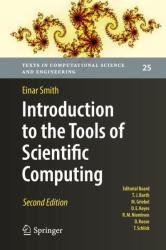 Название: Introduction to the Tools of Scientific Computing, 2nd Edition
Название: Introduction to the Tools of Scientific Computing, 2nd EditionАвтор: Einar Smith
Издательство: Springer
Год: 2022
Страниц: 429
Язык: английский
Формат: pdf (true)
Размер: 10.2 MB
The book provides an introduction to common programming tools and methods in numerical mathematics and scientific computing. Unlike standard approaches, it does not focus on any specific language, but aims to explain the underlying ideas. Typically, new concepts are first introduced in the particularly user-friendly Python language and then transferred and extended in various programming environments from C/C++, Julia and MATLAB to Maple and Mathematica. This includes various approaches to distributed computing. By examining and comparing different languages, the book is also helpful for mathematicians and practitioners in deciding which programming language to use for which purposes. At a more advanced level, special tools for the automated solution of partial differential equations using the finite element method are discussed. On a more experimental level, the basic methods of scientific Machine Learning in artificial neural networks are explained and illustrated.
In the basic Python chapter, we introduce the function concept and illustrate how derivatives can be approximated using discrete difference quotients.
In the chapter on Scientific Python, we expand this idea in the approximation of ordinary differential equations. In comparison we show how the same sample problems can be solved with integrated solver operators.
The chapter on Symbolic Python shows how symbolic solvers can facilitate or replace the numerical solution process.
In the C chapter we show how the sparse matrices that were already used in Python can be generated by machine-oriented, low-level programming using pointer constructions to implement linked lists.
The Julia chapter illustrates how the fundamental programming techniques discussed so far can be formulated in a promising newcomer to mathematical programming, which aims tocombine the elegance ofPython with the performanceof C/C++.
We then show how corresponding ideas are implemented in commercial programming environments such as Matlab and Maple.
The book is primarily aimed at students of mathematics and disciplines in which mathematical methods play an important role. A certain level of mathematical maturity is recommended. Technically, however, only very basic ideas from linear algebra and analysis are assumed, so that the book can also be read by anyone with a solid high-school education in mathematics who wants to understand how mathematical algorithms can be performed by digital computers. Programming experience is not required.
The book is written in such a way that it can also serve as a text for private self-study. With the exception of a few advanced examples in the Matlab and Maple chapters, you can run all programs directly on your home computer, based on free open source programming environments. The book can therefore also serve as a repetition and to improve the understanding of basic numerical algorithms.
Скачать Introduction to the Tools of Scientific Computing, 2nd Edition